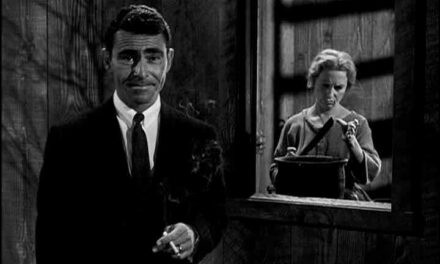‘Remember the Red Indian. When he saw the first steam train, his savage mind thought it an illusion, too.’ Thus begins Doctor Who in 1963 when two teachers Ian and Barbara enter a police box and swiftly find themselves patronised by an alien time traveller, the Doctor. Bewildered by the alien technology around them and unable to understand how the TARDIS could be large on the inside but only a police box on the outside, the teachers soon overhear the Doctor comparing them to the ‘Red Indians’. This line is now very dated but the way the Doctor feels about humans in his present incarnation remains the same. In his most recent adventure ‘The Girl who Died’, he tells the assembled Norsemen ‘I deplore your stupidity’. His comments connect across the decades with the First Doctor’s now very un-PC comment and connect with other incarnations. The Third Doctor, brought to life by Jon Pertwee in velvet, satin and lace frills, was especially prone to outbursts of patronising behaviour, including upbraiding his companion Jo for not understanding Latin.
The other factor that has remained constant throughout Doctor Who is the central character’s use of an academic title. In her major study of science, scientists and Doctor Who, Lindy Orthia points out that a title such as Professor or Doctor is a way of bestowing academic credibility something that the Doctor uses to his benefit. Occasions when he has met professors and other academic élites are when the programme has raised ambiguous and sometimes disturbing messages about education. Although Doctor Who has been widely praised for its wide intellectual horizons and promotion of intellectual curiosity, two stories in particular deliver disturbing moments when the Doctor advocates an élitist outlook.
An unsettling conversation occurs in ‘The Two Doctors’. There the Doctor meets Professor Joinson Dastari, whom he praises highly, telling Dastari that he has ‘more letters after your name than anyone I know. Enough for two alphabets’.
Dastari is also head of research in an establishment that is a powerhouse of scientific talent. He has used his skills in genetic engineering to intellectually augment his servitor Chessene. She is an Androgum, a member of a debased species of food obsessed labourers. He is, in the Doctor’s estimate, a mad scientist but the madness resides in Dastari’s ambition to bring intelligence to another. The Doctor is appalled, and ultimately his concern at the implications is justified as the augmented Chessene is unable to overcome her degraded nature and kills Dastari. As is characteristic of mid-1980s Doctor Who, her degrading intellect has grotesque visual representation. As she became more intelligent, Chessene became more beautiful, but as she degrades, her features coarsen and so does her behaviour, culminating in a scene where she begins to drink the Doctor’s spilt blood in a sign of debased instinct overtaking her intelligence.

Wrapped up in the failure of Dastari’s experiment is a compelling set of points about education. Dastari, a brilliant professor, wanted to share his brilliance, but the disturbing message at the heart of this educational relationship (one more than a little reminiscent of Dr Moreau’s efforts with the creatures on his island) is the limitations of education, as the Doctor himself insists in a tongue lashing to Dastari that there are some who should not be educated:
Doctor: She’s still an Androgum. You can’t change nature.
Dastari: In Chessene’s case, I believe I have.
Doctor: That’s dangerous ground, Dastari. You give a monkey control of its environment, it’ll fill the world with bananas.
Dastari: Doctor, our races have become tired and effete. Our seed is thin. We must hand the baton of progress to others. If I can raise the Androgums to a higher plane of consciousness, there’s no limit to what that boiling energy might achieve.
Doctor: Dastari, I have no doubt you could augment an earwig to the point where it understood nuclear physics, but it’d still be a very stupid thing to do!
Admittedly the Doctor does not always or even often make points like these, although this talk of monkeys and bananas does bring back memories of the ‘Red Indian’ and his savage mind. The conversation with Dastari also has a parallel in the revived series. In ‘Rise of the Cybermen/Age of Steel’the brilliant inventor John Lumic is the scientific adversary whose plan is to convert humans into bio-mechanical Cybermen. The Doctor tells Lumic: ‘everything you invented, you did to fight your sickness. But once you get rid of sickness and mortality, then what’s there to strive for? Eh? The Cybermen won’t advance, you’ll just stop. You’ll stay like this forever. A metal Earth, with metal men and metal faults. Lacking the one thing that makes this planet so alive – people!’ As Orthia points out, the comment is disturbing. As the Doctor told Dastari that he should not bother trying to make his servant smart, a later incarnation of the Doctor tells Lumic he has not the right to use intelligence to try to mitigate his illness. Like Chessene’s physical dissolution from a poised intellect to a blood licking barbarian, Lumic’s intellectual decline becomes visible with the visually grotesque, in this case the audience seeing his brain visible within a cyberman body.

The Doctor’s reactions stem from the plot dynamics and construction of most Doctor Who stories, in which a scientifically adept protagonist (the Doctor) defeats the threat of a scientifically dangerous adversary. Like the 1960s spy series The Avengers, Doctor Who’s creative crucible was one defined by the simultaneous vaunting of the ‘white heat’ of technology and widespread concerns about the destructive implications of science, including through atomic war or pollution. Both series dramatized these concerns through the dangerous research of mad scientists. This early creative impulse has remained a fixture, and for both Dastari and Lumic the Doctor’s warning was part of his usual battle to overwhelm a scientific adversary. But as Orthia points out, the Doctor’s comments to Lumic verge on the fascistic and the same point can be made about his argument with Dastari. There he forcefully suggests that the educational advantages he and Dastari enjoy should not be shared; the servant should remain the servant, as Lumic should stay sick and not strive to be better. He may not always make the point so bluntly, but these exchanges are in line with the general characterization of the Doctor, one repeated most recently in era of the Twelfth Doctor in ‘The Caretaker’ (2014) when the Doctor flatly refuses to believe that the maths teacher Danny Pink could actually be intelligent enough to be a maths teacher, because he had been a soldier. Again, learning is being quarantined, from Androgum servants, the sick Lumic and now soldiers. This scene in ‘The Caretaker’ was unpleasant on several levels. The occasions may be rare, but there is an educational theme in Doctor Who that surfaces from time to time that there are some who, like the ‘Red Indians’, are unteachable.
Dr Marcus Harmes lectures at the University of Southern Queensland, Toowoomba, Australia. He has authored books including Doctor Who and the Art of Adaptation (2014) and the entry in the Devil’s Advocates series on The Curse of Frankenstein.






